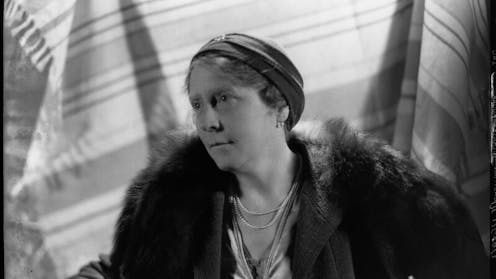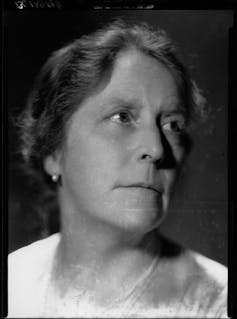Detta inlägg post publicerades ursprungligen på denna sida this site ;
Date:
Author: Rss error reading .
Original article: https://theconversation.com/once-a-bestseller-now-forgotten-why-william-by-e-h-young-deserves-a-revisit-253677

In a year filled with centenaries of famous novels, including Virginia Woolf’s Mrs Dalloway, F. Scott Fitzgerald’s The Great Gatsby and Franz Kafka’s The Trial, another novel also quietly turns 100. William was published in 1925 by the once-celebrated, now largely forgotten, E.H. Young.
William was Young’s most successful novel. It sold more than 68,000 copies and was reprinted 20 times before 1948. It was William which established Young’s reputation as a great writer.
It follows the life of William and Kate Nesbitt and their grown-up children, tracing their trials and tribulations as modern life butts up against traditional values. One of the daughters, Lydia, leaves her husband to live with a novelist. William, a shipowner and the family’s steady centre, supports her. Kate, steeped in traditional respectability, cannot.

National Portrait Gallery, London, CC BY-NC-SA
Two issues lie at the heart of the novel: the role of women and domestic life. Through Kate and William’s relationship, Young breaks new ground as a writer. She explores a later stage of life, when children have grown up. The husband and wife spend time alone and find themselves at odds.
This kind of astute characterisation exemplifies Young’s writing. As with many of Young’s novels, romantic love plays a very small part. The narrative emphasis falls, instead, on other types of relationships.
Women are seen to bear the main burdens of marriage and family life. Again and again, her characters rail against the smallness of middle-class female life and its social conventions.
Looking for something good? Cut through the noise with a carefully curated selection of the latest releases, live events and exhibitions, straight to your inbox every fortnight, on Fridays. Sign up here.
Place and psyche
The novel’s central tension plays out not only in the family, but also in the city they inhabit. William spans the docks and suburbs of fictional Radstowe, a thinly disguised Bristol.
As in Mrs Dalloway, place and psyche are deeply connected. Young uses the physical and social geography of Bristol to examine how women move through a world of unspoken rules.
Young lived in Bristol for 15 years. Most of her novels are set there – or rather in “Upper Radstowe”, her fictional version of real life suburban Clifton. She turned the city’s bridges, rivers and steep class divides into metaphors for the pressures placed on women navigating early 20th-century life.
In William, her characters feel real because they are flawed. The conflict between Lydia’s modern values and Kate’s traditional ones doesn’t resolve cleanly. Young isn’t interested in moralising. Instead, she observes. Her sharp wit, psychological acuity and feel for the rhythms of domestic life make William both an engrossing family novel and a quietly radical one.

Sion Hannuna/Shutterstock
Who was the woman behind Radstowe?
Emily Hilda Young was born in 1880 and died in 1949. She wrote 11 novels and was widely read in her day. Four of her novels were made into BBC radio dramas. Her 1930 novel Miss Mole was televised by the BBC in 1980.
Like many of her characters, Young led an unconventional life. During the first world war she worked as a stable hand and in a munitions factory. Her husband, a solicitor named Arthur Daniell, went off to fight. After Daniell was killed at Ypres in 1917, Young moved to London and got a job in a school where her married lover, Ralph Henderson, was the headmaster.
She was also a keen mountaineer in an era when there were few women climbers. She even pioneered and led others along a route, now known as Hope, in the Carneddau mountains in Eryri (Snowdonia) in 1915.
This quiet radicalism filters into her fiction. Her characters are often sharp-tongued, independent and disillusioned by the roles they’ve been expected to play.
It’s hard to place Young in a neat category, however. Her novels can hardly be described as romances. Love is often portrayed as destructive or imprisoning. Young was a feminist and campaigned for votes for women, but she saw human failings in both men and women. She admired strength of character in spite of gender.
If anything, she’s a 20th-century Jane Austen. Her narratives are witty portrayals of social and family life with psychological depth. In Young, though, there’s a mixture of openness and coldness, and a sarcastic sense of humour which emerges spontaneously. At times, it catches you off guard.
Read more:
Booker prize: rediscovering the first female winner, the often-forgotten Bernice Rubens
Like the best realist writers, Young’s world and its characters are richly drawn. And yet unlike Thomas Hardy or Leo Tolstoy, for instance, Young isn’t interested in tragedy or melodrama. Small troubles are overcome and people make up, even if it doesn’t result in a traditional happy ending.
Young’s legacy has faded, perhaps because her novels sit between genres: not quite realist, not quite modernist, not quite romantic. But as literary anniversaries prompt readers to revisit old favourites, there’s room to bring back overlooked voices.
For readers interested in the inner lives of women, in family dynamics, in novels where place and psychology are intertwined, E.H. Young is worth discovering. This year, rather than returning to the worlds of Clarissa Dalloway and Jay Gatsby, you could instead take a detour to Upper Radstowe, where quiet, deeply human dramas still unfold.
![]()
Rebecca Hutcheon does not work for, consult, own shares in or receive funding from any company or organisation that would benefit from this article, and has disclosed no relevant affiliations beyond their academic appointment.

